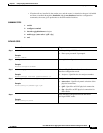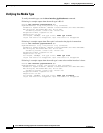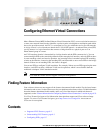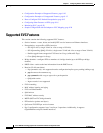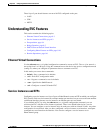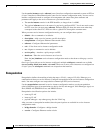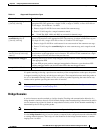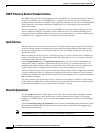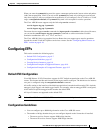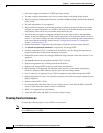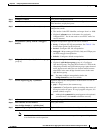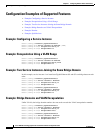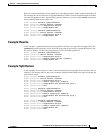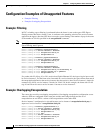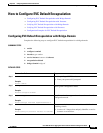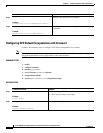
8-7
Cisco ASR 901 Series Aggregation Services Router Software Configuration Guide
OL-23826-09
Chapter 8 Configuring Ethernet Virtual Connections
Configuring EFPs
When you enter the symmetric keyword, the egress counterpart performs the inverse action and pushes
(adds) the encapsulation VLAN. You can use the symmetric keyword only with ingress rewrites and
only when single VLANs are configured in encapsulation. If you configure a list of VLANs or a VLAN
range or encapsulation default, the symmetric keyword is not accepted for rewrite operations.
The Cisco ASR 901router supports only the following rewrite command.
rewrite ingress tag pop 1 symmetric
rewrite ingress tag pop 2 symmetric
The router does not support rewrite commands for ingress push and translate in this release. However,
you can use the rewrite ingress tag pop symmetric command to achieve translation. Possible
translation combinations are 1-to-1, 1-to-2, and 2-to-1.
The Cisco ASR 901 Series Aggregation Services Router does not support egress rewrite operations
beyond the second VLAN that a packet carries into a router. See the “Configuring Other Features on
EFPs” section on page 8-16.
Configuring EFPs
This section contains the following topics:
• Default EVC Configuration, page 8-7
• Configuration Guidelines, page 8-7
• Creating Service Instances, page 8-8
• Configuration Examples of Supported Features, page 8-10
• Configuration Examples of Unsupported Features, page 8-12
Default EVC Configuration
Cisco IOS Release 15.3(2)S introduces support for EVC default encapsulation on the Cisco ASR 901
routers. This feature matches and forwards all the ingress traffic on the port. The default service instance
on a port is configured using the encapsulation default command.
All traffic coming to the interface with default encapsulation is matched and forwarded. This includes
untagged, single tagged, and double tagged traffic. For example, when an untagged EFP is configured,
all the traffic except the untagged traffic matches the default EFP.
All Layer 2 features are supported on the default EVC.
Note Before Cisco IOS Release 15.3(2)S, EFPs or service instances or bridge domains were not configured.
Configuration Guidelines
• You can configure up to 4000 bridge domains on the Cisco ASR 901 router.
• The number of bridge domains that you can configure depends on the license that is installed:
–
The metro services licenses support 4000 bridge domains.
–
The metro IP services licenses support 4000 bridge domains.



